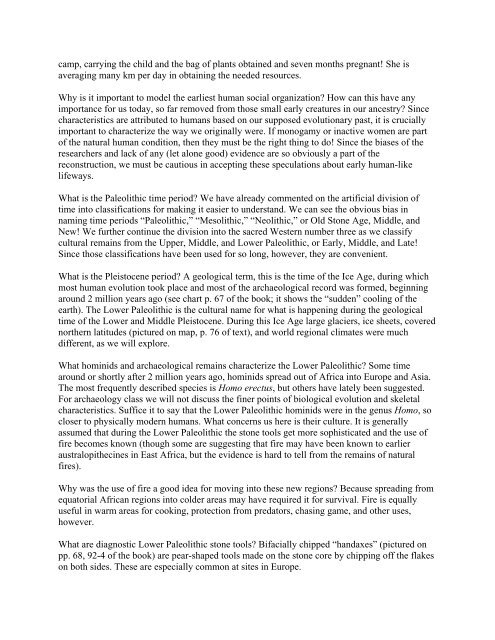INTRODUCTION TO ARCHAEOLOGY Nancy White - Touro Institute
INTRODUCTION TO ARCHAEOLOGY Nancy White - Touro Institute
INTRODUCTION TO ARCHAEOLOGY Nancy White - Touro Institute
You also want an ePaper? Increase the reach of your titles
YUMPU automatically turns print PDFs into web optimized ePapers that Google loves.
camp, carrying the child and the bag of plants obtained and seven months pregnant! She is<br />
averaging many km per day in obtaining the needed resources.<br />
Why is it important to model the earliest human social organization? How can this have any<br />
importance for us today, so far removed from those small early creatures in our ancestry? Since<br />
characteristics are attributed to humans based on our supposed evolutionary past, it is crucially<br />
important to characterize the way we originally were. If monogamy or inactive women are part<br />
of the natural human condition, then they must be the right thing to do! Since the biases of the<br />
researchers and lack of any (let alone good) evidence are so obviously a part of the<br />
reconstruction, we must be cautious in accepting these speculations about early human-like<br />
lifeways.<br />
What is the Paleolithic time period? We have already commented on the artificial division of<br />
time into classifications for making it easier to understand. We can see the obvious bias in<br />
naming time periods “Paleolithic,” “Mesolithic,” “Neolithic,” or Old Stone Age, Middle, and<br />
New! We further continue the division into the sacred Western number three as we classify<br />
cultural remains from the Upper, Middle, and Lower Paleolithic, or Early, Middle, and Late!<br />
Since those classifications have been used for so long, however, they are convenient.<br />
What is the Pleistocene period? A geological term, this is the time of the Ice Age, during which<br />
most human evolution took place and most of the archaeological record was formed, beginning<br />
around 2 million years ago (see chart p. 67 of the book; it shows the “sudden” cooling of the<br />
earth). The Lower Paleolithic is the cultural name for what is happening during the geological<br />
time of the Lower and Middle Pleistocene. During this Ice Age large glaciers, ice sheets, covered<br />
northern latitudes (pictured on map, p. 76 of text), and world regional climates were much<br />
different, as we will explore.<br />
What hominids and archaeological remains characterize the Lower Paleolithic? Some time<br />
around or shortly after 2 million years ago, hominids spread out of Africa into Europe and Asia.<br />
The most frequently described species is Homo erectus, but others have lately been suggested.<br />
For archaeology class we will not discuss the finer points of biological evolution and skeletal<br />
characteristics. Suffice it to say that the Lower Paleolithic hominids were in the genus Homo, so<br />
closer to physically modern humans. What concerns us here is their culture. It is generally<br />
assumed that during the Lower Paleolithic the stone tools get more sophisticated and the use of<br />
fire becomes known (though some are suggesting that fire may have been known to earlier<br />
australopithecines in East Africa, but the evidence is hard to tell from the remains of natural<br />
fires).<br />
Why was the use of fire a good idea for moving into these new regions? Because spreading from<br />
equatorial African regions into colder areas may have required it for survival. Fire is equally<br />
useful in warm areas for cooking, protection from predators, chasing game, and other uses,<br />
however.<br />
What are diagnostic Lower Paleolithic stone tools? Bifacially chipped “handaxes” (pictured on<br />
pp. 68, 92-4 of the book) are pear-shaped tools made on the stone core by chipping off the flakes<br />
on both sides. These are especially common at sites in Europe.
















